ALBANIA
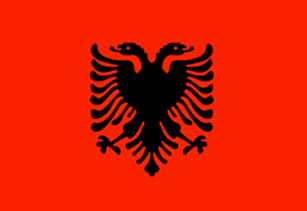
The people of Albania call their country Republika e Shqiperise.
The area that now comprises Albania has been populated since the Illyrians migrated south around 1200 BC. It was under Roman Rule by the 1st century BC, under Byzantine Rule by the 1st century AD, and under Ottoman rule from the 14th century until 1912.
During the first Balkan War, the Ottoman Empire was defeated. Albania declared its independence in 1912.
During World War I, Albania was invaded, and the ruling powers planned to divide it up. However, U.S. President Woodrow Wilson intervened and kept the country intact.
Albania was on its way to becoming a modern state until the onset of World War II when they were invaded by first the Italians then the Germans. There was resistance by various groups including the communist party. At the end of the war, the communist party formed a government led by Enver Hoxha.
Hoxha was a Stalinist communist who ruled with an iron fist. Albania was cut off from the rest of the world until after Hoxha’s death in 1985. The communist party collapsed a few years later.
The communists were soundly defeated in elections during 1992, and it appeared that Albania was on a path to recovery. Then a giant ponzi scheme in 1997 rocked the economy and left it faltering.
In 1999, the Kosovo War caused many Albanians in Kosovo to return to Albania. This put a tremendous stress on a recovering economy. But they continue to recover.
Albania has come a very long way from its 20th century history. They have had a difficult transition from communism to free market capitalism, but this appears to be a much more promising time for most Albanians.
Albania is located on the Adriatic Sea surrounded by Montenegro, Kosovo, Macedonia, and Greece. It is comprised of 11,100 square miles. One third of the land is forested.
In 2011, Albania’s population was 2.8 million. Estimates suggest that 70 to 80 percent of the population is Muslim. Fifty eight percent are employed in agriculture, and the average income is the equivalent of $7,741 USD. Their currency is the Albanian Lek which is worth just under $0.01 USD.
Albania renewed its constitution in 1998. It is a democratic unitary parliamentary republic. The capital is Tirana, and the country is divided in to 122 administrative counties.
Albania is a member of the UN, NATO, and the WTO. They applied for EU membership in 2009. They have diplomatic relationships with many countries.
Cruising boats must use an agent to check in to Albania. We had heard good things about Agim Zholi, and we had exchanged e-mails with him prior to our arrival. Agim was on the dock to take our lines when we arrived.
Boats are not free to anchor out or cruise harbor-to-harbor in Albania. They must stay in the harbor in which they are checked in. So, for the first time in a long time, we berthed in a commercial harbor alongside the stinky belching ferries. In the meantime, Agim quickly had us checked in and free to explore Sarande. Because we will not be sailing to destinations, we will describe our land-based exploration on this page.
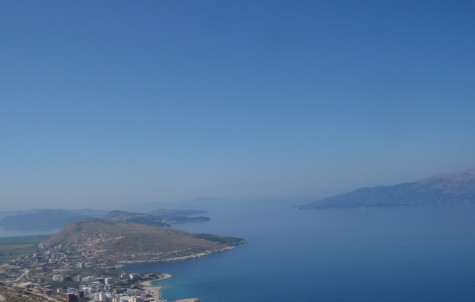
View of Sarande from Lekursi Castle
Sarande is somewhat difficult to describe. It is neither a big nor a small city. It is neither industrial nor rural. It does have a beach (pebbles – no sand) and numerous beachfront businesses, so during the summer it is pretty much a vacation town.
We walked the streets and found the vegetable market, a few bakeries, and a few low key restaurants. We had what we would need for our short stay.
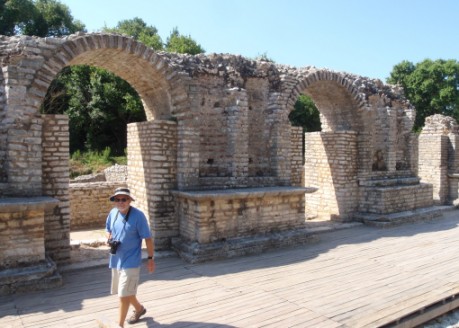
At Butrint
Agim also acts as a travel guide, and he arranged for us to travel to Butrint National Park – a UNESCO World Heritage Site. Although we were growing a bit weary of visiting ruins, this was an interesting place.
Butrint is an archeological site less than 10 miles south of Sarande. It is located on a hill overlooking the Vivari Channel which runs in from the Ionian Sea. It is also close to the Straits of Corfu. Butrint is a microcosm of Mediterranean history representing the rise and fall of the great empires that dominated the region. The archeological remains are monuments spanning over two thousand years from the Hellenistic temple buildings of the 4th century BC to the Ottoman defenses built in the early 19th century.
Some evidence suggests that Butrint may have been settled as early as the 8th century BC, but the first substantial settlement was in the 4th century BC with the creation of a healing sanctuary. Butrint became a flourishing Mediterranean city with the rise of the Roman Empire, and both Julius Caesar and Augustus founded colonies at Butrint. The 5th century spread of Christianity is seen at Butrint in numerous churches, the baptistery, and a basilica built during this period. The Venetians left their mark using Butrint as a military outpost from the 14th to 16th century.
This site was uncovered by an Italian archeological team between 1928 and 1939. It is remarkably intact.
We traveled a few miles inland to Syri i Kalter National Park – commonly called Blue Eye. This park is off the road running between Sarande and Gjirokastra. It is a pretty setting of thick trees – hazelnut, walnut, cherry, pine, and fir. There are 18 natural springs in the park, but Blue Eye is the one people come to see.
Blue Eye is a freshwater spring known for its clarity. The depth of the spring is not known, but it is at least 50 meters (164 feet) deep, and the bottom is visible from the surface. It is called Blue Eye because the center is a dark blue like the pupil of an eye and the surrounding water is a lighter blue like the iris of an eye. The water is very cold. The spring feeds one of the many streams that power two hydroelectric plants downstream. This was a beautiful setting out of the noise of the city.
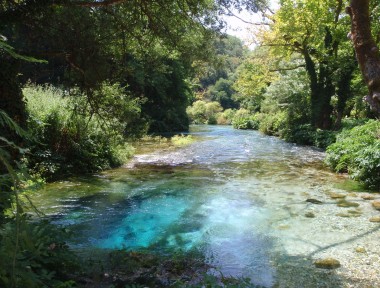
Blue Eye feeding one of many streams
The remains of this castle are on a hill overlooking Sarande to the west, an agricultural valley to the east, and Burtint Lake to the south. Visible further to the east are the mountains beyond which is the town of Gjirokastra which is where we were headed.
Likursi Castle was built in the 16th century by Suleyman the Magnificent when he was trying to conquer Corfu. The location was chosen because of the vantage point it offers in all directions.
Although little of Lekursi Castle remains, the view is spectacular. A cafe has been built on the site, and it blends well with the surroundings. We were told that the view is even better at night.
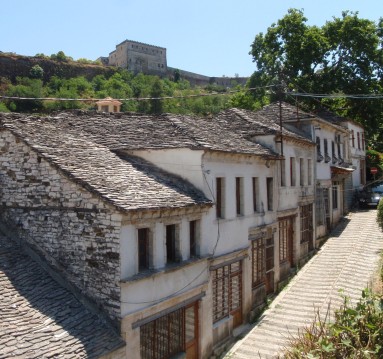
Stone-roofed houses in Gjirokastra
Gjirokastra is an old city, a new city, and another UNESCO World Heritage Site. Gjirokastra is at an altitude of approximately 1,000 feet above sea level, and its population is approximately 43,000.
Gjirokastra means ‘silver castle’. “Grey castle’ would be more descriptive.
The buildings in the old part of town are built of stone. More unusual are their roofs – also stone. The roofs are thin natural stone. This is the first time we have seen this.
Gjirokastra is the birth site of Albania’s former communist leader Enver Hoxha. The home where he was born has become an Ethnographic Museum. The ‘museum’ houses a rather scant collection, but we enjoyed seeing the interior of one of the city’s old stone houses.
Gjirokastra is also the site of frequent political unrest in Albania. The population is largely Greek, and they have often rebelled against the Albanian government. The inhabitants of Gjirokastra were heavily affected by the giant ponzi scheme that collapsed in 1997, and severe political instability arose from there. However, it is seemingly calm at present.
We also explored the Castle of Gjirokastra. The castle was built in three phases. The first phase dates back to the 4th century BC, and it was little more than a fortified center to protect the city within. The second phase was built during the12th to 15th centuries, and it became a large fortress. The final phase was built during the 18th century, and it included an extension of the castle to the west and a seven mile aqueduct. The aqueduct has since been dismantled, and the stones were used elsewhere in the city.
Two features of the castle particularly struck us. First was its excellent condition. Second was the height of the overhead. It is an enormous space inside the structures.
At one time, as many as 10,000 persons lived within the castle walls. Since then, a section of the castle was used as a prison until 1968, and outdoor areas are still used for national folk festivals.
We had seen the local sights, and we were not free to cruise along the coast, so we decided it was time to move on. We had previously planned to continue north to Montenegro then Croatia, but we had since changed our plans. Rather than heading north, we decided to head west through the Med and across the Atlantic. So we checked out of Albania with our next port being Italy.
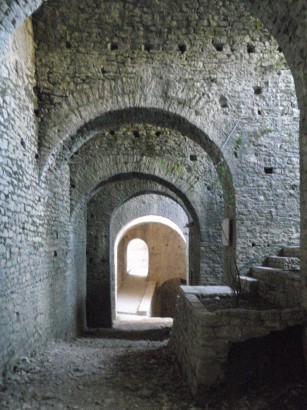
Inside Gjirokastra Castle
Sail along with us from Albania to Italy or jump ahead to Italy.